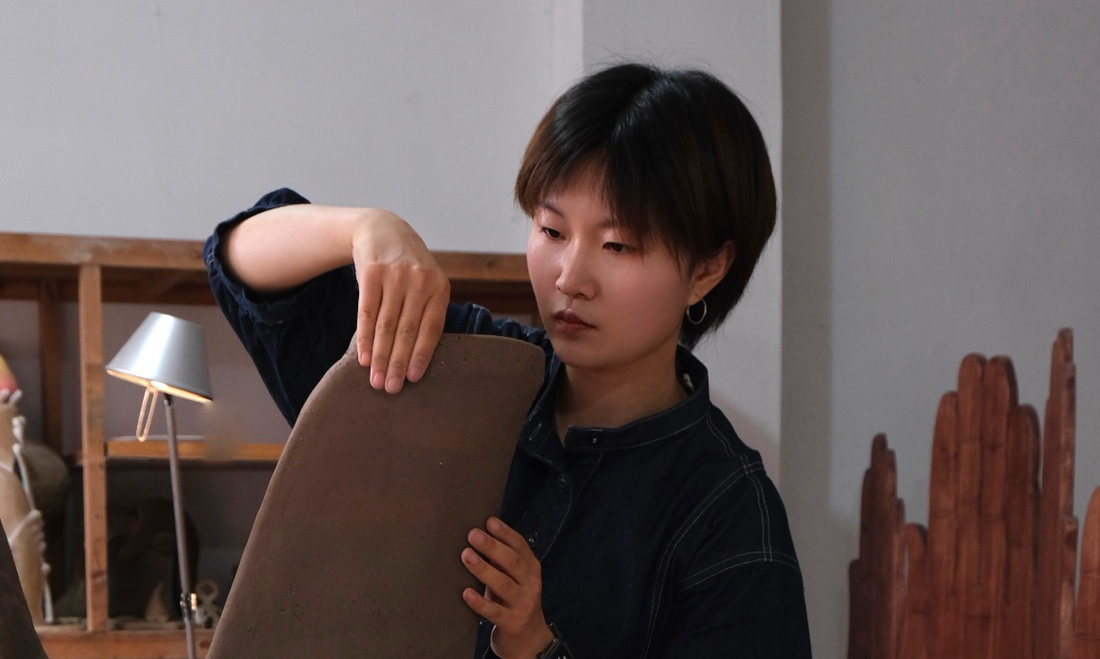
From Hand to Clay: A Dialogue

As a contemporary ceramic artist from Jingdezhen, Xin Li (born in 1996) explores the profound connection between humans and nature in her work. Her distinctive style merges ceramics, visual art, design, and functionality, infusing her pieces with a unique vitality and pure beauty. Xin Li’s creations not only emphasize form’s purity but also communicate the natural transformation of materials through handcraft marks and kiln traces, embodying her understanding of harmony between craftsmanship and nature.
In this interview, TEAOC invites you to delve into Xin Li's artistic world to discover how she uses clay to create soul-soothing works and shares her unique interpretation of life and nature.
Q&A
1.
Mengru Zhou: How did you first encounter ceramic art? What inspired you to choose ceramics as your primary creative medium?
Xin Li: I initially encountered ceramics during my studies in applied arts, where it was a required course. I had originally focused on lacquer art, but a trip to Jingdezhen near graduation introduced me to inspiring ceramic artists and works at the Lok Tin market. This experience expanded my perception of ceramics, driving me to pursue it as a creative medium. I saw a way to sustain myself through ceramics, gained supportive creative companions, and eventually chose ceramics, settling in Jingdezhen.
2.
Mengru Zhou: In your works, natural forms and functionality are seamlessly integrated. How do you view the relationship between functionality and artistry?
Xin Li: I believe functionality and artistry can coexist within a piece and are not contradictory. Although my mentor once suggested that focusing on functionality might compromise artistic excellence, I found that stripping it away didn’t resonate with me. I later came across a paper on “Furniture Design in Art Therapy,” which influenced me to blend functionality and artistry into natural, human-like ceramic furniture and lighting pieces—essentially, “collectible design.”
3.
Mengru Zhou: You mentioned that the flame marks in your pieces symbolize clay's "transformation." How do you perceive these uncontrollable elements in your creative process?
Xin Li: Firing larger or smaller pieces in a wood kiln brings surprises and challenges, letting me deeply experience the allure of flame in ceramics. The uncontrollable factors sometimes drive us to improve technically.

4.
Mengru Zhou: In your “Hand’s Ideal” series, what emotions and thoughts do you wish to convey through these traces?
Xin Li: I aim to convey an honest, warm ideal of life created by hand. Living in Jingdezhen, a city of artisans, I’m inspired by laborers who build their lives through their hands. This led me to create practical, hand-shaped furniture that transforms into life scenes and offers comfort to others.
5.
Mengru Zhou: Your works often reflect a warm, primal essence. Where does this emotion stem from, and how does it influence your life or creations?
Xin Li: This feeling comes from soil and the earth. Growing up on the Loess Plateau instilled a natural affinity with land, and the freedom of running on the hills as a child fuels my adult resilience and love for life. My works help me heal through this connection.
6.
Mengru Zhou: As an artist inspired by nature, do you draw from specific natural elements or landscapes? Do these environments influence your creative process?
Xin Li: Environmental changes spark new ideas. In spring, I incorporate trees and birds, crafting small, hand-rooted chairs that reflect my desire to grow and thrive like spring plants.
7.
Mengru Zhou: Your “Hand Series” emphasizes handmade traces. What meaning do these marks hold for you?
Xin Li: Rhythmic hand traces give the work strength and intricate detail.
8.
Mengru Zhou: The natural texture and soft hues in your works seem to reflect Eastern ideals of harmony and balance. How do you see these philosophies manifested in your work?
Xin Li: Growing up with Eastern culture, these values naturally resonate with me. Modesty and balance reflect my personality, influencing my interactions and striving for balance in life and work. This harmony appears organically in my creations.
9.
Mengru Zhou: Has your creative journey deepened your reflection on humanity's relationship with nature? How is this relationship expressed in your work?
Xin Li: Ceramic materials come from nature, yet waste from firing is challenging to recycle into the ecosystem. I aim to create quality works, recycle unused clay, and be eco-friendly in my process, showing reverence for nature.
10.
Mengru Zhou: What emotions do you hope audiences feel when they interact with your work? Do you wish for them to find healing or inner peace?
Xin Li: I hope viewers feel warmth and kindness, sensing the care I put into each piece. I would love for my creations, which have comforted me, to provide solace to others as well, encouraging them to cherish objects and people and, hopefully, find peace within.
This conversation opens a window into Xin Li’s profound journey, where art and nature converge. Her work invites us to embrace the warmth of handmade creations, celebrating the balance between tradition and modernity.
Written by Mengru Zhou
